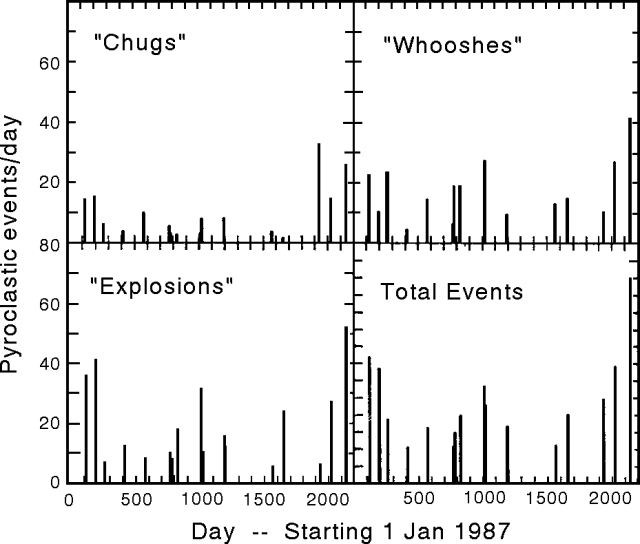Report on Arenal (Costa Rica) — November 1992
Bulletin of the Global Volcanism Network, vol. 17, no. 11 (November 1992)
Managing Editor: Lindsay McClelland.
Arenal (Costa Rica) Lava flows, Strombolian activity, and gas emission
Please cite this report as:
Global Volcanism Program, 1992. Report on Arenal (Costa Rica) (McClelland, L., ed.). Bulletin of the Global Volcanism Network, 17:11. Smithsonian Institution. https://doi.org/10.5479/si.GVP.BGVN199211-345033
Arenal
Costa Rica
10.463°N, 84.703°W; summit elev. 1670 m
All times are local (unless otherwise noted)
Lava production, intermittent Strombolian activity, and gas emission continued from the active summit-area crater (C). Activity continues to build a lava delta on the WSW slope. The most recent flow continued to advance through pre-existing channels, reaching 855 m elevation on 5 December, near the terminus observed in May. The flow was ~200 m wide and 10 m thick. Temperatures of the crust at the flow front reached 480°C, but the red interior exceeded 800°C. Blocks overflowed levees on both sides of the other lobe's channel, where it was obstructed at ~1,100 m elevation. Occasional pyroclastic flows left deposits on the W and SW flanks.
Ash ejected by the Strombolian activity occasionally rose >1 km above the crater and was carried by winds onto the NW, W, and SW flanks (table 5). Blocks and bombs fell on the upper flanks, to 1,000 m elevation. As usual, the more intense explosions vibrated windows of houses in La Fortuna, 6.5 km E. Between 14 and 22 November, the rate of audible pyroclastic activity monitored from the Arenal Observatory lodge . . . averaged 120 events/day (figure 51).
Table 5. Deposition rates, volume, and size distributions of ash collected 1.8 km W of Arenal's active crater, at 735 m elevation, 23 April-5 December, 1992. Courtesy of ICE.
| Dates | g/m2 | (g/m2)/day | Medium to very coarse ash | Fine ash to dust |
| 23 Apr-12 May 1992 | -- | 4.3 | 0 | 100% |
| 12 May-10 Jun 1992 | 538 | 20.1 | 34.7% | 65.3% |
| 10 Jun-24 Jun 1992 | 174 | 12.4 | 46.4% | 53.6% |
| 24 Jun-19 Jul 1992 | 457 | 17.6 | 51.8% | 48.2% |
| 19 Jul-25 Aug 1992 | 559 | 15.1 | 46.7% | 53.3% |
| 25 Aug-09 Sep 1992 | 106 | 7.1 | 37.0% | 63.0% |
| 09 Sep-23 Sep 1992 | 183 | 13.1 | 33.3% | 66.7% |
| 23 Sep-14 Oct 1992 | -- | 36.2 | 49.3% | 50.7% |
| 14 Oct-05 Nov 1992 | -- | 33.7 | 55.1% | 44.9% |
| 05 Nov-05 Dec 1992 | -- | 14.6 | 51.1% | 48.9% |
Summit fumarolic activity remained vigorous, and gases were carried W by the trade winds. Vegetation on the NW, W, and SW flanks continued to be affected by acid rain, and falling blocks and bombs, as it has over the past 24 years. Steep slopes and high rainfall continued to trigger small cold avalanches in flank canyons (quebradas Guillermina and Calle de Arenas, and the río Agua Caliente).
In November, seismic activity averaged 25 events/day, with a maximum of 51 (on the 9th). Tremor activity had also declined somewhat.
Geological Summary. Conical Volcán Arenal is the youngest stratovolcano in Costa Rica and one of its most active. The 1670-m-high andesitic volcano towers above the eastern shores of Lake Arenal, which has been enlarged by a hydroelectric project. Arenal lies along a volcanic chain that has migrated to the NW from the late-Pleistocene Los Perdidos lava domes through the Pleistocene-to-Holocene Chato volcano, which contains a 500-m-wide, lake-filled summit crater. The earliest known eruptions of Arenal took place about 7000 years ago, and it was active concurrently with Cerro Chato until the activity of Chato ended about 3500 years ago. Growth of Arenal has been characterized by periodic major explosive eruptions at several-hundred-year intervals and periods of lava effusion that armor the cone. An eruptive period that began with a major explosive eruption in 1968 ended in December 2010; continuous explosive activity accompanied by slow lava effusion and the occasional emission of pyroclastic flows characterized the eruption from vents at the summit and on the upper western flank.
Information Contacts: G. Soto and R. Barquero, ICE; E. Fernández and J. Barquero, OVSICORI; W. Melson, SI.


